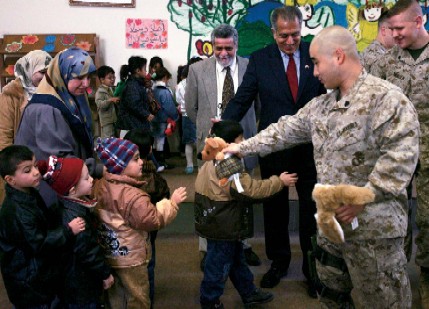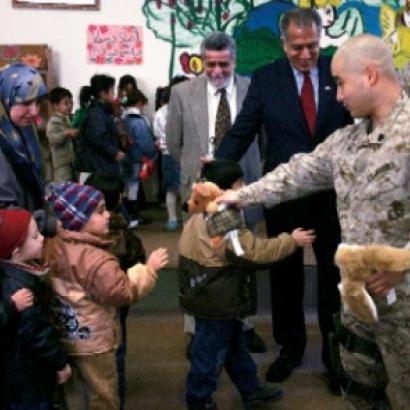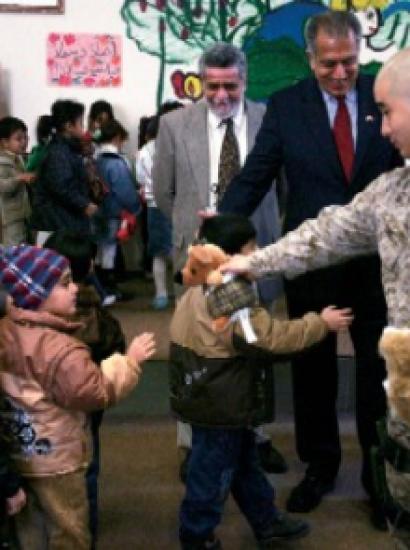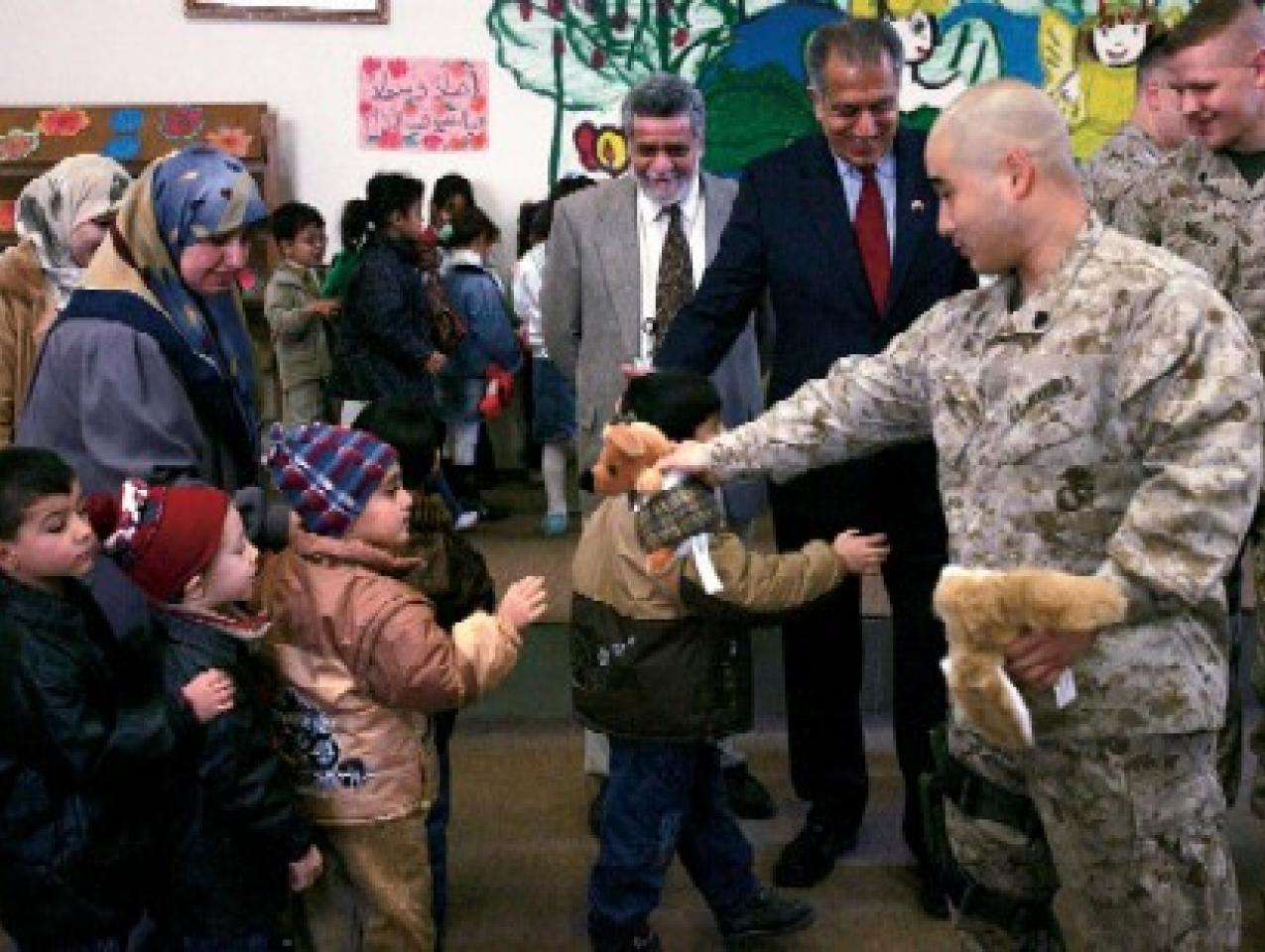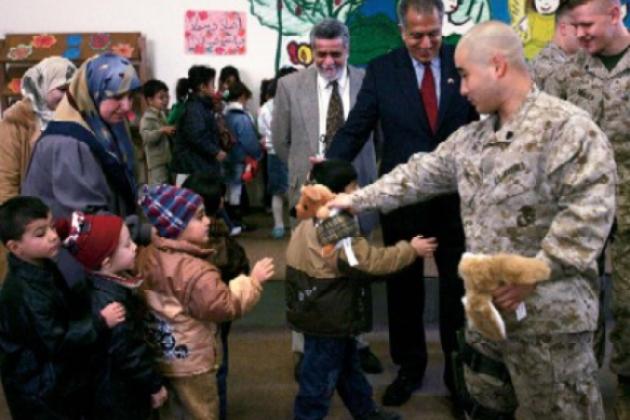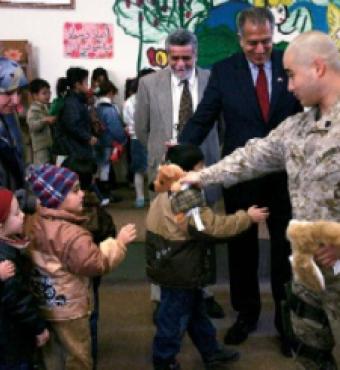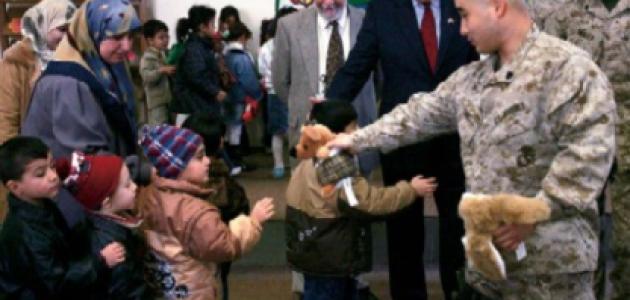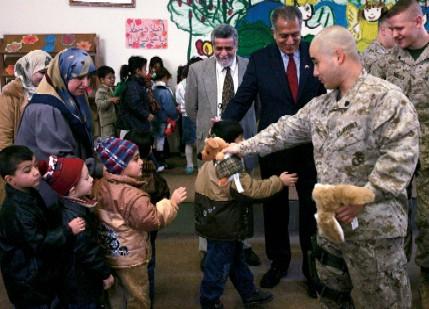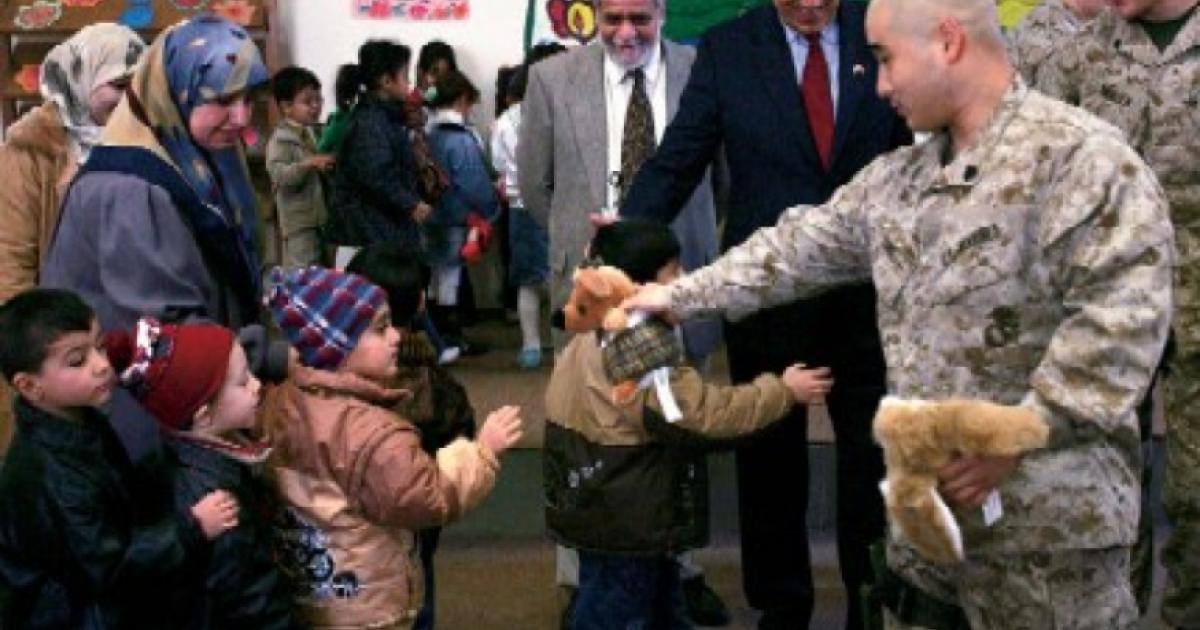The Iraq war is at its core a counterinsurgency. The insurgency opposes progress through violence and subversion. The counterinsurgency in turn must promote and protect progress, fulfilling the people’s desire for security, prosperity, freedom, and health. The Iraq counterinsurgency is particularly complex, given the necessity of securing and transforming an Iraqi nation ruined by Saddam’s cruel regime. This struggle is nothing short of a political battle for the control and future of Iraq.
HEARTS AND MINDS
Both the insurgency and the counterinsurgency are competing for the support of the population. To succeed, the Iraqi government and the U.S.-led Coalition must protect and control the population, ensuring their security by preventing the insurgents from intimidating and influencing the population. Security forces must deny insurgents sanctuary, prohibiting their ability to stage operations and eliminating their forces. These tasks are now being achieved more routinely by the increasingly capable Iraqi forces. Such progress is vital to the Iraqi government’s ability to regain the monopoly on violence, so fundamental to resurrecting Iraq as a nation-state.
Further, the government must reduce the underlying causes of insurgency by meeting popular expectations, many of which require considerable time, manpower, and money. With mixed economic and political progress, Iraqis remain disgruntled. Communicating with the population exposes insurgent deceptions and failures and promotes tangible achievements. To date, Iraqi government and Coalition communication efforts have been unsatisfactory. The insurgency cannot operate effectively without some support from the population, or at least its ambivalence. Unmet expectations create hopelessness, which feeds ambivalence toward the insurgency and skepticism toward the government and its allies.
Following a remarkably successful invasion, our inability to tangibly deliver on Iraqi popular expectations has squandered a window of opportunity, setting back Coalition efforts and raising the importance of the security tasks higher than was otherwise necessary. Further, frequently ad hoc efforts were exacerbated by civilian and military leaders pursuing dual strategies guided by often-incongruent directions from the Departments of State and Defense. Moreover, these failings undermined the political standing of secular Iraqis—our natural allies—and empowered radical, sectarian leaders and their militias, adding malicious factional violence to the challenge of an already active insurgency.
Despite this setback, Iraqi force development and the adaptation of the
U.S. military has steadily progressed. Following the mid-2004 recognition that the conflict in Iraq was fundamentally an insurgency, plans were developed to confront it properly, including security, government, economic, and communication efforts.
| Security, representative government, and a productive economy cannot be achieved without the consent of the Iraqi people. |
The imperative for government and economic development in a counterinsurgency was best described by Sir Gerald Templer, architect of the prototypical 1950s British success in Malaya, when he stated, “The shooting side . . . is only 25 percent . . . 75 percent lies in getting the people of this country behind us.” In Iraq, we appear to have seriously underresourced the nonmilitary “75 percent.” Security resources remain plentiful and responsive; government and economic development resources, less so.
Security in Iraq faces diverse challenges from disparate groups with varied motives. Using violence, Sunni insurgents seek to restore Sunni rule to Iraq, secure otherwise unattainable political concessions, or mount a “good resistance” against foreign occupiers. Iraqi and foreign affiliates of Al Qaeda covet Iraq as a base from which to further subvert the Middle East. The principal Shiite militias—Muqtada al-Sadr’s Mahdi Militia, once actively insurgent, and the Iranian-trained Badr Corps of the Supreme Council for Islamic Revolution in Iraq—are subversive, threatening rivals and citizens. Criminals, organized and petty, serve all who pay. The Kurds in northern Iraq, while not insurgent, do clash with neighboring Iraqi groups, disrupting the north and complicating Coalition plans.
Implementing a strategy against these diverse threats is tough. However, the diffuse nature of the insurgency, the often-conflicting objectives of Sunni insurgents and jihadist terror groups, and competition among Shiite militias all favor Coalition and Iraqi efforts.
Iraqi and Coalition forces cannot be defeated militarily, but the war in Iraq has become a struggle for the support of the people. Security, representative government, and a productive economy cannot be achieved without the willing consent of the people. Insurgents and jihadist terrorists seek to deny this consent by attacking Coalition and Iraqi forces, Iraqi government institutions, and, increasingly, the civilian population. The insurgents need only for the government to be unsuccessful. Here, political progress is the leading indicator and violence the lagging indicator of success.
DECLINING INSURGENCY?
Insurgents and terrorists have failed in many respects. They remain largely confined to the Sunni provinces. Unchecked sectarian violence or civil war remains unrealized. No safe haven has been established since Fallujah was lost. Foreign support remains limited. Iraqi forces have improved, not collapsed. Insurgent and terrorist infighting has increased as political advances include a greater Sunni role. The Sunni insurgency endures but has not progressed.
| History’s hard lesson is that counterinsurgencies are not settled quickly. Successful counterinsurgencies in the twentieth century averaged nine years. |
Insurgents rely on terror when they are weak and conduct large-scale operations when they are strong. The character of insurgent violence marked by reliance on remote attacks on security forces and terror against the population implies a weakness that was less evident in 2003 and 2004. Moreover, at its worst, Iraq’s violence remains consistent with that experienced in past insurgencies.
Insurgents lose when fighting Coalition forces; improved U.S. tactics saw reductions in U.S. deaths (6 percent) and wounded (25 percent) between 2004 and 2005, trends that continue. As a result, the insurgents have shifted their focus to Iraqi security forces and civilians, which now suffer three-quarters of all casualties. Iraqi forces are a prime target because the insurgents know that such capable forces pose the greatest long-term threat. Their concern is valid. Iraqi forces are operating with greater independence. They were steadfast in the face of recent sectarian violence. They have become the arbiter of security across more and more of Iraq. In particular, the Iraqi army is achieving a national identity.
The quality and quantity of information freely provided by the population are the clearest indication of success or failure. Tips from the population have increased tenfold over the last year, with most resulting in successful operations.
Election turnout also heralds declining insurgent influence. In the December 2005 Iraqi legislative elections, the turnout was 78 percent, a percentage greater than the United States has seen since 1876. Greater popular support for the political process is also fracturing links between Sunni insurgents and Islamist terror groups.
The insurgents are losing the initiative because their casualty rates are rising out of control. Initiative is an advantage all combatants seek. Iraqi and Coalition forces now kill and capture far more insurgent fighters in their own operations than in reactions to insurgent actions.
| Our improved tactics have led to reductions in U.S. casualties since 2004. As a result, the insurgents have shifted their focus to Iraqi security forces and civilians, which now suffer three-quarters of all casualties. |
Popular attitudes toward political, security, and economic issues—and the future—indicate the Iraqi people’s confidence in their government. Iraqis are seeking order and a better life, which insurgents cannot offer. Polling of Iraqis consistently shows confidence in the future and opposition to violence against all Iraqis; the desire for Coalition withdrawal routinely ranks below economic, political, or other security concerns. Nevertheless, Iraqi confidence in their new, four-year government will depend on progress in these areas, and frustration is rising with the pace and scale of economic recovery.
Although security progresses, the threat of civil war underlies all insurgencies, fed by unmet expectations and perceived and genuine injustices. Opposition to the recent Al Qaeda Samarra mosque bombing permits accommodation. Thus, while sectarian strife persists, the internal Iraqi lead-ership—crucial to sparking or preventing civil war—again joined together to prevent the transformation of strife into civil war. This is critical. Coalition forces can effectively mitigate many crises; however, history suggests that a foreign force can do little to resolve a civil war except to back a side. Nonetheless, the insurgency continues.
RECOVERY WOES
Security is insufficient by itself to defeat the insurgency. More must be done to meet popular expectations and consolidate political progress by improving government, economic, and social conditions. Even if U.S. ambassador Zalmay Khalilzad forges a national compact between the factions and even if future constitutional revisions preserve continued Sunni participation, reasons for concern remain.
Iraq’s people, its economy, and its government were ruined by Sad-dam Hussein. Saddam’s reign was a kleptocracy that squandered the best government and economy in the Middle East. Under Saddam, Iraq endured three major wars and three corresponding economic depressions and turned into a debtor nation; illiteracy skyrocketed; and per capita GDP fell from the region’s highest to its lowest. Iraq is now vulnerable to instability in every measurable area. Iraqis have been shattered by decades of autocratic terror. Saddam murdered and terrorized his people, subjected them to sanctions, and exploited ethno-religious divides. The 2003 invasion ended this misery but did not replace it with an alternative system of order.
| Without tangible progress in reconstructing Iraq, even the most clever and aggressive communication efforts to sway Iraqi opinion (or that of our own citizens) will fall on deaf ears. Deeds matter. |
Reconstruction remains plagued by poor planning, inadequate and inflexible funding, and a project-based approach both inappropriate to Iraq and incapable of creating the viable economic sectors so desperately needed after years of decay. Estimated reconstruction demands are as high as $100 billion, and Iraq’s direct foreign investment requirements may be as high as $250 billion.
International funding is insufficient. Security and foreign company overhead consumed about two-thirds of the initial $30 billion U.S. investment, limiting tangible results. Very little of the $13 billion in donor pledges has materialized, and most has been consumed by the Iraqi budget and corruption. Falling Iraqi oil revenues cannot meet national budget demands or fund development. Finally, Iraq is deeply in debt, despite forgiveness by most debt-holding nations.
Effective governance is nearly nonexistent. A functioning Ba’athist bureaucracy was a myth. The provincial reconstruction teams and ministry assistance teams aimed at building government and economic capacity are woefully undermanned. Limited investment also plagues the development of civil society institutions vital to democracy. Counting on democratic consolidation in the foreseeable future is very unrealistic.
Without tangible progress in those areas, even the most clever and aggressive communication efforts to sway Iraqi opinion (or that of our own citizens) will fall on deaf ears. Deeds matter more than words.
| Even absent an insurgency, political and economic transitions take time. In Eastern Europe, the move to liberal democracy and market economies continues even today, some 15 years after the collapse of communism. |
The inadequate postinvasion investment in government and economic development that aggravated Iraq’s failings continues. Counterinsurgency is in effect “combat nation-building,” yet investment is imbalanced. Annually, nearly $70 billion is devoted to “combat” and $10 billion to “nationbuilding,” a sum in dramatic decline. Military outlays cannot decrease, but nonmilitary investment must increase—quickly.
Iraq is simply in no position to progress politically or economically without assistance. Lack of economic progress alienates the population from its own government and emboldens Sunni insurgents and subversive Shiite groups backed by Iran. This fosters the insurgency, can spark greater sectarian violence, or even foment civil war: outcomes contrary to U.S. objectives.
In addition, insufficient economic and government development increases the risk in several areas. Iraq may succumb to underlying sources of instability. Iraqi support for democracy may wane as it has in other regions. Overdeveloped Iraqi security forces may attempt a coup in the face of a generally weak and ineffective government. Sunni disenfranchisement may sustain the insurgency or incite civil war. A stagnant economy can limit modernization and feed corruption.
MOVING FORWARD: KEY STEPS
Redoubling our effort over the next several years is critical. It will require serious political willpower and some tough policy decisions. Aggressive domestic and international engagement will be needed to build the constituencies necessary to support a long-term venture. The following steps must be uncompromising and comprehensive:
| Iraq is simply in no position to make progress without massive assistance. |
- Unify. As Iraqis assume greater responsibility for security, the Coalition role will evolve. This offers an opportunity to consolidate the mission under a single authority. Although military resources dominated the U.S. effort in Iraq, unifying civil and military control under the ambassador or the military commander was bureaucratically unrealistic. The U.S. effort in Iraq needs a single person at the helm—this led to success in the British Malaya campaign and will work in Iraq.
- Expand. The scope and scale of the Iraq undertaking would benefit from the involvement of an expanded, constructive U.S.-coordinated international partnership, including the United Nations, the European Union, NATO, and nations currently involved such as Great Britain and new ones such as India. All these partners could bring practical skills and resources to provide development of the economy, government, rule of law, and civil society, as well as increasing Iraqi access to global education and training opportunities. Rhetorical or symbolic coalitions have proven inadequate.
- Secure. U.S. forces should decline only as conditions merit. Plans and resources must be readied for emergencies such as a coup or civil war. As Iraqi forces and the political situation mature, U.S. forces can progressively reduce, but transition team advisers in Iraqi army and police units should not. The presence of advisers can aid development of professional Iraqi security forces responsive to civilian control, loyal to the nation, and less likely to attempt a coup or collapse into Lebanon-like ethnoreligious disorder. This advisory presence, from battalion to ministry level, must be a persistent, 10-year effort.
- Guide. Extending functional governance across Iraq requires dedicated manpower with the right skills. The Department of Defense is the only federal agency configured for large-scale operations outside the United States. Manpower from other U.S. agencies, volunteers, nongovernmental and international organizations, and contractors will likely be insufficient, especially in the near term. The urgency of this need calls for an imaginative use of our military reserves to exploit their civilian skills and their military obligation. Planned staffing of provincial reconstruction and ministry assistance teams is less than 2,000—history suggests the need for a fivefold increase. As with the military force, these numbers could diminish over time, but a core presence could be required for a decade or longer.
- Invest. Iraq’s recovery needs are rising. Partially effective, initial U.S. funding has had limited effect and has been largely consumed. Given estimates that Iraq can absorb about $10 billion in economic assistance annually and absent major progress with donations, direct foreign investment, or oil revenue, another $20 billion is warranted. Unlike the initial U.S. investment or typical foreign aid, however, this money must be flexible and should be granted at the lowest level—where visibility, impact, creativity, and entrepreneurial spirit are the greatest and where overhead and corruption are the lowest.
- Communicate.Often imperceptible progress and an unpersuasive communication effort undermine the war of ideas and international, regional, Iraqi, and U.S. popular attitudes. An aggressive, coordinated, and relentless effort should leverage best practices that include World War II–style public information campaigns, overt and covert efforts from the Cold War, and effective methods discarded after the 2003 invasion.
-
Persist. History’s hard lesson is that counterinsurgencies are not settled quickly. Successful counterinsurgencies in the twentieth century averaged nine years. Britain’s often-touted success in Malaya took 12 years. Even absent an insurgency, political and economic transitions take time. Consider that Eastern Europe’s move to liberal democracy and a market economy continues today, some 15 years after the collapse of communism.
Success is possible in Iraq but not without adjusting course. Achieving the fundamental security, political, and economic conditions that underpin free societies will require imaginative policy and significant amounts of money, manpower, and time. In October 2005, Secretary of State Condoleezza Rice conceded that it may take a decade to achieve success in Iraq, a realistic estimate of what is currently an underresourced effort.







